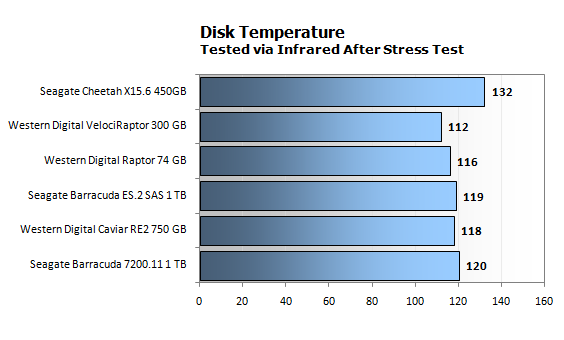Seagate Cheetah 15K.6 Hard Drive
Heat and Power Consumption
Heat and Power Consumption
With a maximum power consumption rating of 17W and peak idle decibel level of 36 dbA (seek/write decibel levels are not listed in its spec sheets), the Cheetah 15K.6 appears to be a somewhat scary drive in terms of specifications. In short, it sounds like it will run hot and loud, which is exactly what most are trying to get away from in their systems. Low heat and noise are two of the main factors why solid state hard disks are so appealing.
Let’s start off with heat. In order to test the heat of the Cheetah 15K.6, we ran an Iometer stress test on each drive after their normal testing was finished, and measured the temperature of the drive on both its side and top. The Iometer stress test uses the “Database” pattern and runs for 30 minutes. Unlike most high-end (10K+) hard drives, the Cheetah 15K.6 has no integrated heatsink functionality, meaning it is relying solely on the environment and cooling around it. The drives were tested in a temperature controlled room at 78F with no active cooling.

We were honestly very surprised to see that the Cheetah 15K.6 performed so admirably here. Throughout most of our testing, the 15K.6 did not appear to get very hot, only lukewarm in most scenarios. Of course, once you bundle them up closely in a rackmount, thermal issues may become apparent, but this is true for any high-end hard disk. For the most part, we believe Seagate’s claims of performance per watt appear to be true, as the drive is very tolerable in terms of heat for a 15,000 RPM unit, and potential buyers shouldn’t be scared about this fact when considering one of these drives. As for power consumption, we tested these enterprise class drives in their normal fashion. We attached a hardware wattage monitor to the system which monitors the wattage load of the entire system (not just the hard disks). We read the total system power consumption numbers with each hard drive in idle mode (after Windows bootup, after everything has loaded and spin down) and during full load (performing a disk intensive Iometer test). Full system specifications for the surrounding components can be seen on the following page.


Our power consumption numbers for the 15K.6 and ES.2 SAS drives are somewhat higher due to the additional power consumption of the SAS controller card in the mix. In any case, the power consumption numbers aren't too bad here, as our 15K RPM drive with a SAS controller consumes about 20-30W more compared to our 10K RPM hard disk. This is to be expected, but the results are not too bad.
The final environmental aspect is noise, which I feel is the largest concern. Heat issues can be solved fairly easily by using a case fan (assuming you’re not in a tightly packed rackmount) and power consumption issues aren’t too bad (again, true for rackmounts, but high-wattage desktop power supplies are fairly cheap). Noise is a harder issue to deal with though, and its stated 36 dBA noise level is certainly high.
Luckily, Seagate appears to be fairly conservative here as well. The Cheetah 15K.6 first makes itself apparent during the initialization of your SCSI controller, where you’ll hear the drive quickly ramp up from producing zero noise to its idle level. With a single Cheetah 15K.6 drive, the noise level isn’t that bad, but with multiple drives, they definitely become noticeable in any sort of reasonable low noise environment. As for read/write noise levels, thankfully they were much lower than anticipated. The drives are audible when performing disk intensive operations, but not to the point where we would consider them a nuisance. The noise levels were above our ambient level, but the pitch was low, which makes it fairly easy to tune out. Interestingly enough, the noise levels which we noted on the Cheetah 15K.6 were lower than our Raptor 10K drives, which have a lower “rated” decibel level. Western Digital’s newer VelociRaptor drive, however, was definitely quieter than the Cheetah 15K.6. As someone who is extremely noise sensitive, it wouldn’t pain me to put one or two of these drives into a personal workstation and sit by them, day in, day out.






